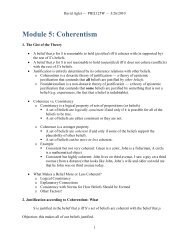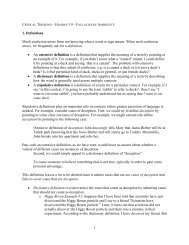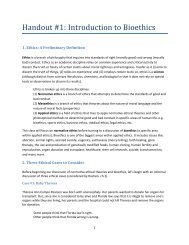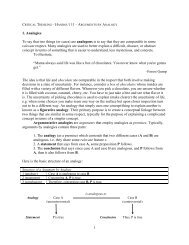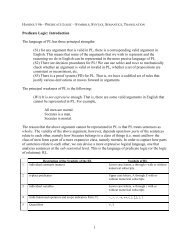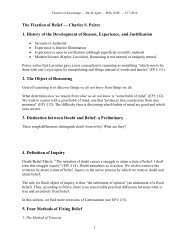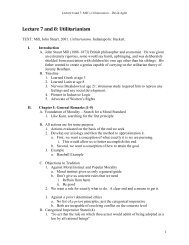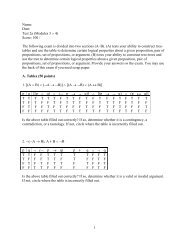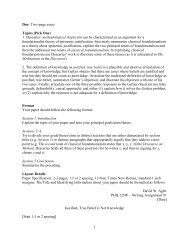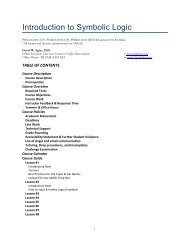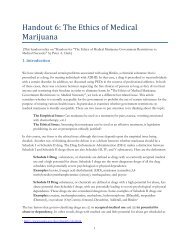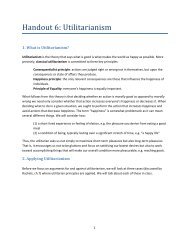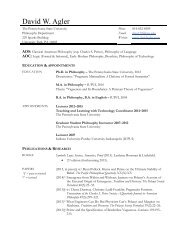9.3 <strong>Language</strong> & <strong>Syntax</strong>The language <strong>and</strong> syntax of ML extends the language <strong>and</strong> syntax of PL. As such, ML retainsthe symbols used to represent propositions, truth-functional operators, <strong>and</strong> scope.1 Uppercase Roman (unbolded) letters (‘A1,’ ‘A2,’ ‘B,’ ‘C,’ …, ‘Z’) with or without subscriptedintegers for propositional letters2 Truth-functional operators (¬, ∧, ∨, →, ↔)3 Parentheses, braces, <strong>and</strong> brackets to indicate the scope of operatorsML extends PL with the following two one-place operators: ◊ (the diamond) <strong>and</strong> □ (the box).The syntax of ML allows for affixing the diamond “◊” to the left of a proposition P such that“◊P” is read as “It is possible that P” or “P is possible.” Similarly, the box “□” can be affixed tothe left of a proposition P such that “□P” is read as “It is necessary that P” or “P is necessary.”4 Two one-place modal operators (◊ <strong>and</strong> □)As with PL <strong>and</strong> RL, the syntax for ML can be formulated using a set of formation rules.Namely, a proposition in ML is a well-formed formula (wff) if <strong>and</strong> only if can be formulated bythe following set of rules:(1) Single propositional letters A, B, C, ..., Z with <strong>and</strong> without numerical subscripts arewffs.(2) If P is a wff, then so is ¬(P).(3) If P <strong>and</strong> R are wffs, then so are P∧R, P∨R, P→R, P↔R.(4) If P is a wff, then so is ◊(P) <strong>and</strong> □(P).(5) Nothing else is a wff except in virtue of (1)–(5).Similar to the syntax of PL <strong>and</strong> RL, two conventions are adopted for the scope of 1-placeoperators. Convention #1 is that parentheses are optional when a 1-place operator operates upona single propositional letter or another 1-place operator. Thus, ¬(P), ◊(P), ◊(□(P)) can besimplified to ¬P, ◊P, <strong>and</strong> ◊□P, respectively when “P” is a single propositional letter. Convention#2 involves the use of braces [ ] <strong>and</strong> brackets { } when a set of parentheses is contained inanother set of parentheses. Thus, P∨(S∨(M∨(L∧T))) is more perspicuously symbolized asP∨{S∨[M∨(L∧T)]}.As in PL, formation rules are used recursively to create any wff in ML. To illustrate,consider the following:Show that □◊P is a wff.1 P is a wff Rule 12 If P is a wff, then ◊P is a wff. Rule 4 + Line 13 If ◊P is a wff, then □◊P is a wff Rule 4 + Line 24
The use of the formation rules for ML begin with identifying the needed propositional letters,proceed to attaching those operators having the least scope, until the operator with the mostscope is attached. As a final example, consider a more complicated use of the formation rules:Show that ¬(□◊P→□R) is a wff.1 P <strong>and</strong> R are wffs Rule 12 If R is a wff, then □R is a wff. Rule 4 + Line 13 If P is a wff, then ◊P is a wff. Rule 4 + Line 24 If ◊P is a wff, then □◊P is a wff. Rule 4 + Line 35 If □◊P <strong>and</strong> □R are wffs, then □◊P→□R is a wff. Rule 3 + Line 2, 46 If □◊P→□R is a wff, then ¬(□◊P→□R) is a wff. Rule 2 + line 5Exercise Set #1A. <strong>Syntax</strong>: Identifying well-formed formulas. State whether the following are well-formedformulas in ML.1. ◊P2. □¬P3. ¬□(P→R)4. □□(P→R)5. □P→R6. P□∧P7. P□→P◊8. ¬◊¬P9. ◊(□P)10. ¬P□¬PB. <strong>Syntax</strong>: Using the formation rules. Using the formation rules provided in this chapter, showthat the following formulas are wffs.1. ◊P2. □P3. ¬□P4. □(P→R)5. □¬(P→R)6. ◊□P7. □◊P8. □(◊P↔R)9. ◊□P∧¬□◊P10. (□P→□□P)→(□□P→□P)9.4* Types of Relations: Preparation for 9.5Intuitively, a relation is some way in which two or more objects are connected or taken together.For example, if John is taller than Liz, we say that one way that John <strong>and</strong> Liz can be takentogether is through the taller-than relation. The st<strong>and</strong>ing-between relation is another example. If5



